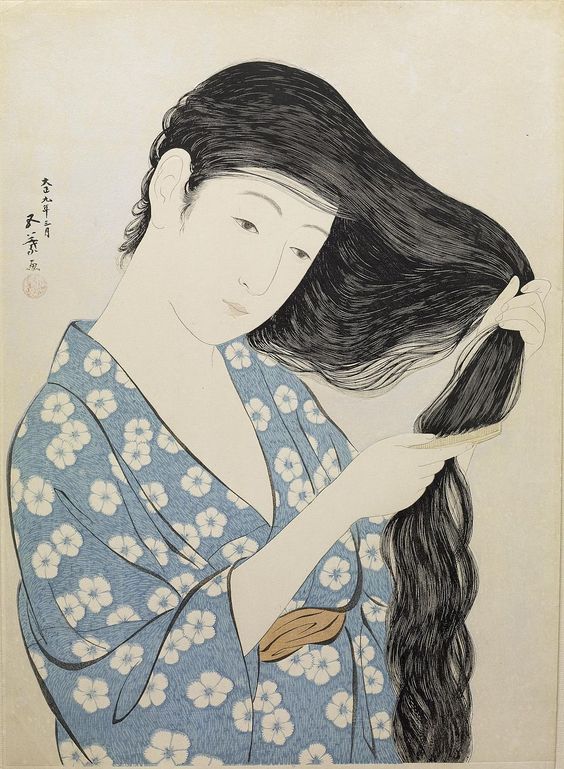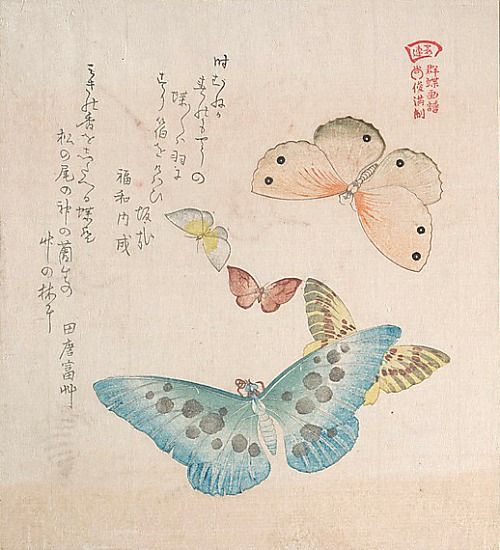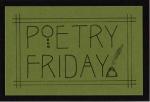
Issa is probably my favorite of the four great haiku masters. I love the endearing humanity in his poems and seeing traces of his personality shining through. How could I not appreciate a poet whose pen name translates as “cup of tea,” or, “a single bubble in steeping tea”?
Recently, I was happy to stumble upon some of his “soup” haiku (many about pufferfish soup). While I’ll pass on pufferfish every time, I can certainly get behind this poem:
thin mist —
night after night
vegetable soup
Don’t you think Issa wrote it with me in mind, knowing its irresistible aroma would awaken my senses 213 years later? 🙂
Because May is the fifth month, today I’m serving up five of Issa’s “blue” haiku, paired with Japanese woodblock prints. Enjoy these lovely one-breath poems (all translated from the Japanese by David G. Lanoue). I hope their beauty will add a little joy, light, and the sweet fragrance of revelation to your day.
*

like blue sky
the summer kimono
I’m wearing
*

with a light heart
in this world —
light blue butterfly
*

how quiet
the light-blue morning glory —
such good manners
*

sky-blue parasols
one by one —
blossoms at their peak
*

all the way
to the blue sky’s edge —
low tide
*
Master Issa, Arigato! *bows*
*
 The beautiful and talented Brenda Harsham is hosting the Roundup at Friendly Fairy Tales. Join her lovely “Starry, Starry Spring” celebration and check out the full menu of poetic goodness being shared in the blogosphere this week. Happy Weekend!
The beautiful and talented Brenda Harsham is hosting the Roundup at Friendly Fairy Tales. Join her lovely “Starry, Starry Spring” celebration and check out the full menu of poetic goodness being shared in the blogosphere this week. Happy Weekend!
Copyright © 2018 Jama Rattigan of Jama’s Alphabet Soup. All rights reserved.

Such beautiful artwork! Thanks so much for sharing it!
LikeLiked by 1 person
Glad you liked it. I always appreciate the deep serenity in Japanese art — the power of understatement.
LikeLiked by 1 person
simply exquisite, Jama, and I love your “blues” theme. Thank you for brightening a gloomy day!
LikeLiked by 1 person
I’m all about “think blue” this year. Glad this post brightened your day. Have a nice weekend!
LikeLiked by 1 person
My favorite color, blue. Thanks, Jama, for this breath of fresh air! I loved the images and the haiku, none of which I’d encountered before.
Wondering about the term “one-breath.” Is it a nod to haiku’s brevity, breathing into the spiritual space of that moment, or….?
LikeLiked by 1 person
Doesn’t surprise me that you’re a blue girl — the color of ocean and sky. 🙂
“One breath” is often used to describe haiku for the reasons you mentioned — brevity as well as spirituality. I find haiku incredibly calming — because you are forced to slow down and contemplate . . . and breathe, of course. 🙂
LikeLiked by 1 person
So much beauty in such a small compass. Thanks for sharing this, Jama. It was exactly what I needed today.
LikeLiked by 1 person
Glad the poems and art resonated with you today, Amy!!
LikeLike
Yes, gorgeous. I will keep on trying to learn from Issa. These are wonders of blues. Thanks, Jama!
LikeLiked by 1 person
Putting together this post reminded me that I need to read more haiku. They’re like a tonic for the soul . . . 🙂
LikeLiked by 1 person
Beautiful! Do you mind my asking where you got your little notebooks and pencils?
LikeLiked by 1 person
I dug into my old stationery stash for the pencils and notebooks. A friend sent them to me years and years ago after she visited Japan (they make the cutest paper goods!).
LikeLike
Yes, they do make lovely paper goods and pencils and erasers of course. How nice to have an old stash!
LikeLike
Love this post! Especially needed its beauty and calming effect this morning!
LikeLiked by 1 person
Oh good — glad this post hit the spot for you, Melissa. 🙂
LikeLike
Oh, how lovely! I especially enjoyed the morning glories with their good manners. Now I’m wondering about plants that are not so polite. Vines that grow over a fence? Tomatoes that can’t hold themselves up? Branches that snag your clothes? Oh, I know–shrubs that leave seeds stuck to everything that passes by!
LikeLiked by 1 person
The morning glories is probably my favorite. Love your list of impolite plants — sounds like a batch of fun poems in the making.
LikeLike
Just right for today… or any day! Thank you, Jama!
LikeLiked by 1 person
Thanks for visiting, Jessica!!
LikeLike
What a beautiful, peaceful post to wake up to Jama, I love this haiku especially,
with a light heart
in this world —
light blue butterfly”
though they are all wonderful, and so sensitive, and the art complements the haikus perfectly! I just saw an exhibit at the Chicago Art Institute on”Modern Japanese Portraits,” of painters turned printmakers http://www.artic.edu/exhibition/modern-japanese-portraits. Thanks for this refreshing post!
LikeLike
Sounds like a wonderful exhibit, Michelle. I love learning whatever I can about Japanese art. 🙂
LikeLiked by 1 person
I’d like to post some of the pics I took of it if I can fit it in sometime …
LikeLiked by 1 person
Of course he wrote it for you! Thanks for sharing all these blues.
LikeLiked by 1 person
I’ve often thought that the best poems are the ones that feel like they were written just for you — that resonance and sense of intimacy IMHO are crucial . . .
LikeLike
Ahhh, all the way to the sky’s edge, beauty! I’m happy to sit among the well-mannered morning glories, butterflies, and gently envy that sky-blue kimono. What a happy person this Issa must have been. I also love the wee dolls visiting your stationery! (Don’t you just love those kind of pencils? They make everything you write more gorgeous.) I’m so glad you collect things that make BOTH of us happy.
LikeLiked by 1 person
From what little I know of Issa’s background, it sounds like he had a hard life — which makes me appreciate his work even more — as he was able to transcend temporal struggles and concerns for his art.
LikeLike
These are all making me so very nostalgic for Japan!
LikeLiked by 1 person
Sigh. I’ve only visited once and found it sooooo fascinating. Don’t even get me started on all the good food. 🙂
LikeLike
I love the pairings of paintings and poems! I have the Lanoue translation, too. Have you read the children’s book Cool Melons—Turn to Frogs: The Life and Poems of Issa, by Matthew Gollub and Kazuko G. Stone? It tells more about his difficult life. It’s really lovely.
LikeLiked by 1 person
I love that book and reviewed it here:
LikeLike
Hooray! Except for the sadness. The poem about the stepchild’s kite really broke my heart. Thanks again for the Issa poems today.
LikeLiked by 1 person
These are lovely — the parings of poem and painting are just perfect!
LikeLiked by 1 person
Thanks, Joy!! Glad you enjoyed the post. 🙂
LikeLike
Of course, I am SWOONING over this beautiful post, Jama! The pairing of these poems and the gorgeous art is so thoughtful and creative. And of course, that soup poem was written just for you.
I agree that Issa’s haiku are all the more powerful because of the challenges and tragedies he faced in his life.
LikeLiked by 1 person
I thought of you while selecting the haiku for this post, Robyn. 🙂
LikeLike
Thanks for the peaceful blue poems and paintings, bringing me some calm, Jama 🙂
LikeLiked by 1 person
My pleasure!
LikeLike
Your pairings of poems and prints are exquisite and heighten the impact of the haiku. I really enjoy receiving the Daily Issa, but these were all new to me. Thanks!
LikeLiked by 1 person
Thanks — so glad you enjoyed today’s post!
LikeLiked by 1 person
Wonderful, Jama. And I loved all of your books. Your post inspired this haiku:
a sage
adds spice to soup
in good thyme
🙂
LikeLiked by 1 person
Love it, Brenda!!
LikeLiked by 1 person
Lovely, lovely, Jama! So well said of your selection of Issa’s “blue” haiku: “lovely one-breath poems.” The Japanese woodblock prints you paired them with are exquisite.
LikeLiked by 1 person
Thanks, Alice. I enjoyed pairing the haiku with the art. 🙂
LikeLiked by 1 person
The deep blues of the mountains in the last woodblock were stunning. Lonely images and poems.
LikeLiked by 1 person
I meant lovely, not lonely. 🙂
LikeLike
Kawase Hasui is one of my fave woodblock artists! I recently did a post featuring more of his “blue” prints:
LikeLike
Gorgeous pairings!
LikeLiked by 1 person
Thanks — glad you enjoyed them.
LikeLike
These are fabulous! Thank you for sharing them. Isn’t it amazing when something written centuries ago feels like it’s just for you? Ruth, thereisnosuchthingasagodforsakentown.blogspot.com
LikeLiked by 1 person
Yes, quite amazing. Issa’s haiku seem remarkably fresh and contemporary in some ways.
LikeLike
Oh, I love these Issa poems. My favorite is the last one, and the rich tones of the print are gorgeous. I am going back to Japan this fall, and your post seems part of the dreaming and preparing.
LikeLiked by 1 person
Lucky you going to Japan in the Fall!! Hope the trip inspires some good writing. 🙂
LikeLike
The images (not to mention the haiku) make me swoon. So gorgeous.
LikeLiked by 1 person
Thank, Myra!!
LikeLike
Lovely.
LikeLiked by 1 person
Thanks for stopping by, Bridget!
LikeLike